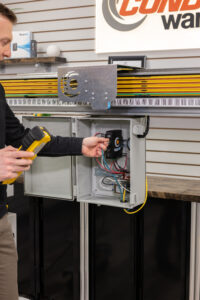 Tell us about yourself, Andrew.
Tell us about yourself, Andrew.
I am the Director of Product Management and Marketing at Conductix-Wampfler, a leader in the industrial electrification industry. With a Bachelor of Science in electrical engineering from the University of Nebraska-Lincoln, I have dedicated the majority of my career to product innovation throughout the entire lifecycle from concept through fruition.
Could you give us some background information on Conductix-Wampfler? What makes it a leader in mobile electrification and data transfer systems for industrial machinery?
What sets Conductix apart in the industry and makes us a leader in mobile electrification and data transmission is our breadth of products, expertise, and 35-plus years of experience in the field. Data is not a new thing for us. We have a long history of innovating with data in industrial environments, evidenced by generations of products, including Powertrans, ProfiDAT and Nexus BB.
We design, manufacture, and install/service a wide range of other solutions like conductor bar systems, transit conductor rails, slip ring assemblies and industrial power transfer systems, as well as cable festoons, spring-driven cable reels, and motor-driven cable reels. In addition, we offer an array of crane controls, including push button pendants, radio remote controls, and bumpers. For assembly areas, we engineer compressed air and electric delivery systems and offer workstations, spring balancers, and air balancers.
By offering premiere and custom-tailored solutions to meet clients’ needs for mobile electrification, data transfer, and other areas of their facilities, Conductix has distinguished itself as a leading provider of versatile and reliable systems. Our field-proven products safely and reliably operate in the most demanding industrial applications of various types.
 What types of products and services does Conductix offer?
What types of products and services does Conductix offer?
Safety and reliability are critically important when it comes to industrial machinery. You need clear lines of communication to gather data properly and make informed maintenance decisions, but we often hear that the biggest challenges in the industry are related to system infrastructure. Plant managers can add various sensors to equipment, but if they can’t get the data back to a central serve, the insight is limited. Without the foundational infrastructure to enable data transmission and collection, there’s untapped potential for predictive, prescriptive and periodically scheduled maintenance. And, of course, that untapped potential comes with consequences like decreased reliability, unplanned downtime, and possible safety concerns.
At Conductix, the biggest value we can offer is helping the industry’s businesses gather the available and necessary information. We do this by providing a data network that feeds from mobile equipment to a central server. When you have data like this readily available, you can better execute condition monitoring, assess maintenance needs and optimize equipment care – effectively extending the life of valuable equipment.
Our products and services span a variety of applications and markets, but we can look at the rail industry as one example. Our Power Rail Intelligence System (PRIAS) is a comprehensive technology that evaluates the health of rail systems. PRIAS, alongside our team of engineers, can find and diagnose power rail problems before they adversely impact operations. This is one specific example of how our tech can be leveraged to pinpoint and prioritize areas that need maintenance.
For those outside the rail industry, we have other data transfer solutions. We provide customers with the ability to move information to a customized endpoint. Because of the breadth and depth of our products, we’re able to tailor solutions around each customer’s goals. From there, we offer installation and ongoing inspection services. Our team of professional inspectors is available to confirm that systems are running properly, suggest predictive maintenance, or recommend equipment optimizations.
What advice would you give someone or a company looking to determine when it is best to rebuild, retrofit with new technology, or replace outdated machinery?
When considering if it’s best to rebuild, retrofit, or replace outdated machinery, it all boils down to return on investment (ROI). I would keep my advice simple, with two steps. First, inspect your system to see how capable it is of measuring and reporting information. That assessment allows you to develop an informed plan that works best for you, considering your current and future operational needs.
Once you’ve assessed your current system’s capabilities compared to your current and future operational needs, you can decide whether it makes sense to add on to existing equipment or update the infrastructure. For instance, some data-over-power solutions can be used on new and existing systems to add a secure data communication layer without requiring any networking expertise.
 As it pertains to the implication of Industry 4.0 and automation, what data are plant teams gathering from their equipment, and how can you leverage that data into predictive maintenance and a full picture of operations?
As it pertains to the implication of Industry 4.0 and automation, what data are plant teams gathering from their equipment, and how can you leverage that data into predictive maintenance and a full picture of operations?
When it comes to predictive maintenance, plant teams are likely looking at all the data that impacts wear and tear on equipment. This includes cycles and speeds of equipment, environmental conditions of the facility and electrical characteristics. Monitoring the electrical characteristics might not seem like an obvious recommendation, but it’s important because the power you’re transmitting directly impacts your equipment’s life. Clean power leads to equipment that runs smoothly. Sparks, brownouts, and other power challenges shorten the life of your electrification equipment.
From an overarching operations perspective, plant teams should look at sensor data. Sensors can be added to anything you want to measure or run – like smart assembly devices, mobile test fixtures, cranes and more. Sensors aid in quality control checks and provide invaluable operational data. Plant teams can take sensor data one step further by leveraging video. In the past, plant teams have encountered bandwidth limitations in using video sensors and have only used them in fixed positions, which isn’t the most helpful from a data perspective.
As plant teams look ahead to 2023 and determine the data they need to capture, many are considering how their operations can leverage video, whether product, personnel or task-related. We’ve had customers come to us for solutions to feed video back to central servers for quality assurance and control. This can be done with data-over-power solutions like Nexus BB, which create a secure signal and eliminate the need for Wi-Fi – boosting security and reliability. Tying it back to Industry 4.0 and automation, video sensors open up a whole world of possibilities with what can transmit data and the visibility available to plant teams to inform maintenance decisions.
What is the importance of taking stock of current equipment and calculating the cost to you and your business if it breaks?
It’s essential to take stock of current equipment and calculate the cost to you and your business if it breaks. It’s especially important to go through this exercise proactively. Being able to plan for equipment issues is more valuable than addressing them retroactively. While my expertise aligns with the technical side of industrial machinery, I can’t dictate the ROI calculation process – only the facility owners and operators can calculate that and understand the business implications of possible downtime.
What improvements need to be made for the sake of cybersecurity?
When it comes to improving the cybersecurity of industrial machinery, the first step is choosing the right technology for your infrastructure. Assess your current IT infrastructure and network options, and ensure that your equipment works well with that setup. Ask yourself if Wi-Fi is the ideal solution for your equipment – if it’s not, consider creating a subnetwork completely separate from Wi-Fi for security and performance. Think about wireless vs. hardwired networks and which is most advantageous based on safety or channel traffic.
What are the benefits of standardizing a facility with automated operations, and what role does this play in safety and reliability of new or established plant equipment?
There are several benefits to standardizing a facility with automated operations. From a reliability perspective, standardized operations are more scalable, familiar to plant teams, and easier to maintain. There’s less of a learning curve because it’s more practical and efficient to learn the intricacies of one standard system. Standardized operations are also more cost-effective when it comes to spare equipment. With fewer variations in equipment, there are fewer spare parts needed.
Additionally, automation and standardization create more opportunities for data-driven decision-making. When equipment is standardized, more data can be collected and analyzed. This allows plant teams to form a better view of the holistic operations picture and manage maintenance needs more efficiently and proactively.
Is there anything else that you’d like to include?
As plant teams think about overall efficiency and optimizations, there’s one last thing with interesting potential to leverage: modular and flexible workstations. For example, if you have a bus that powers a line, you can consistently rebalance your production line or move around modular systems to change your workflow regularly. This tends to work well in low-volume, high-mix facilities that frequently need to rebalance or change over product lines. These types of facilities can leverage equipment, in addition to automation, to be modular, boost efficiency, and gain flexibility.













































